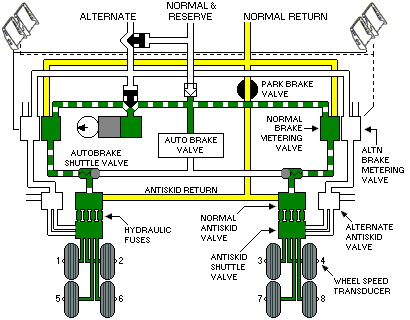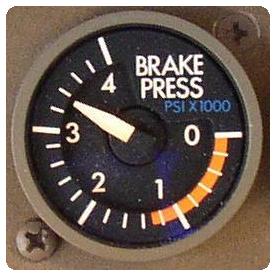Brake Accumulator 

If right/reserve, and alternate brake hydraulic power is lost, the brake accumulator can provide several braking applications or parking brake application.
When the Alternate Brake system is pressurised, brake accumulator pressure is maintained by closing an accumulator isolation valve. This preserves the accumulator pressure for use if the Alternate Brake System should also fail. In the event of a total active hydraulic brake source loss, the accumulator isolation valve opens to provide one and possibly more applications of brake power through the normal brake lines.
- See: Parking Brake
Brake Source
![]() The BRAKE SOURCE light illuminates and the EICAS advisory message BRAKE SOURCE displays if both the normal and the alternate brake system pressures are low. The light extinguishes if the Reserve Brakes system is selected and pressure is available. If the BRAKE SOURCE Light remains illuminated, the Brake Accumulator is the only source of power to the brakes.
The BRAKE SOURCE light illuminates and the EICAS advisory message BRAKE SOURCE displays if both the normal and the alternate brake system pressures are low. The light extinguishes if the Reserve Brakes system is selected and pressure is available. If the BRAKE SOURCE Light remains illuminated, the Brake Accumulator is the only source of power to the brakes.
- Only accumulator pressure is available for braking. During landing rollout, apply steady, increasing brake pressure and hold to a full stop. Do not taxi.
[Prevents possible loss of braking due to accumulator depletion]
Note: The antiskid system operates normally. The following entry from the AMM is provided for information only.
- Initially, on landing, use partial pedal inputs (approximately one third pedal travel). As the rollout continues, further pedal travel may be necessary.
- Ensure that the nose wheel is on the ground and the speedbrakes extended before applying brakes.
- Apply steady pressure and DO NOT PUMP the pedals.
- Braking requires even greater care during light weight landings. 32-42-1
Brake Pressure Indicator

The Brake Pressure Indicator shows the pressure in the Brake Accumulator. An initial pre-charge is shown by the amber band (1300 psi) on the indicator. A reading at or below the amber band indicates no Brake Accumulator pressure is available.
Boeing During cruise, observed brake pressure on the brake pressure indicater may drop from 3000 psi to 2500 psi, and then increase back to 3000 psi during descent. This drop in flight deck brake pressure indications at cruise is due to thermal effects (i.e. low ambient temperatures at cruise altitudes) on the accumulator gas charge and is considered normal.